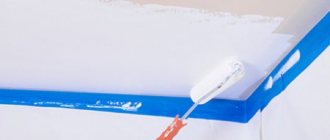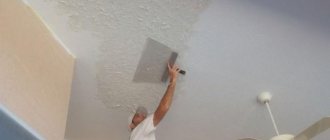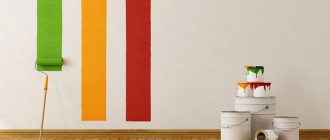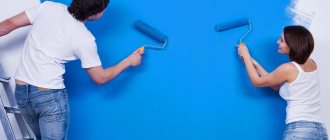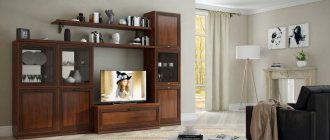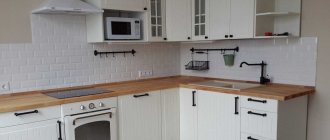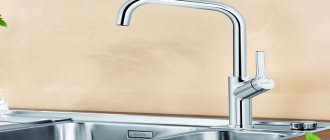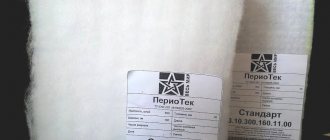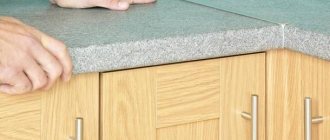Water-based paint is considered the best option for walls in a house or apartment. It has a lot of advantages, for which it is appreciated. The name indicates the main components of the paint and varnish material. It consists of a water-based emulsion containing undissolved polymer particles. Additional components in the composition: coloring pigment and additives that improve the characteristics of the water-based emulsion.
The composition is water-based; after painting, the water begins to actively evaporate, leaving a layer of thin polymer film on the surface. This is one of the safest types of paints and varnishes that can be used even in a children's room. The range of products is large, everyone will be able to choose an option for themselves, taking into account the cost and technical characteristics.
Types of water-based paint
Before painting your walls with water-based paint, it is important to decide and choose the appropriate composition. The differences between them are in the polymers used. There are 4 types of water-based paints:
- Acrylic water-based paint is based on acrylic resins. The result is a smooth surface, the paint and varnish material adheres well and is able to mask minor defects in the walls. It is easy to work with acrylic-based water-based emulsion; it has excellent coverage and is vapor permeable. Disadvantages: high cost and hygroscopicity. Therefore, acrylic-based paint is suitable for dry rooms. But by adding latex to the composition, it acquires moisture-proof properties. Dried water-based latex paint will also become elastic. The downside is that the cost increases.
- Silicate water-based paint is made on the basis of liquid glass. The advantages of the composition are that the paint layer is resistant to moisture, mechanical damage and durable. Despite the high price, it will last more than 10 years. Can be used indoors and outdoors. Vapor-tight.
- Mineral water-based paint is made from lime or cement. Its advantage is excellent adhesion to any surface. However, this is one of the worst options for decorative painting, since the layer is quickly washed off and becomes unusable. The price is the lowest, so the compositions are used for domestic premises.
- Silicone water emulsion is the newest development of all. It applies perfectly, allows you to hide cracks up to 2 mm (acrylic up to 1 mm), the wall turns out smooth, even and well protected. The layer is dense, vapor permeable. This is ideal for wet rooms (kitchen, bathroom). The cost is high.
It is allowed to add latex to any type of paint and varnish material. For silicone paint this is impractical, but for other types of water-based paints, latex will make them elastic and protected from moisture.
It is impossible to say unequivocally which of the listed paints is better, since for each room you should select the type of water-based emulsion that would be advisable to use in a particular case, based on the type of room, the price of paint, etc.
Popular manufacturers
There is a wide variety of water-based compositions on the market. The best quality products are produced by European manufacturers such as Tikkurila, Dulux and Dufa. Products from well-known brands are expensive, but have excellent consumer characteristics and a proven reputation. Inexpensive paints from little-known companies are not always synonymous with low quality, but before purchasing, it is recommended to study reviews of such products on the Internet.
Choosing paint and roller
The final result depends on this stage, so it should be taken seriously. It is worth thinking in advance what kind of paint and additional tools will be used, and what kind of roller is needed. There is a formula: high-quality paint material + suitable tools = ideal painting quality. Plus, you will need basic skills in working with water-based emulsion.
When buying paint, it is a good idea to consult with the seller. He will tell you which composition is suitable for a particular room, and also announce the rules of use. A good paint is one that has a certificate or certificate of conformity. The best manufacturers of paints and varnishes:
- Tikkurila;
- Dulux;
- Marshall;
- Alpina.
After purchase, you need auxiliary tools and materials for work:
- hard brush;
- soft plastic brush;
- sandpaper;
- masking (construction) tape;
- rollers and handles for them;
- dry rags;
- putty knife;
- bath for rollers;
- acrylic based primer.
Advice! Buy work clothes and shoes, or choose from old items. During the work process, it will not be possible to avoid dirt and paint drops.
Which roller is better? It all depends on the type of work being performed. When painting an uneven or textured wall, use a roller that has the ability to remove the top coat. The pile is medium or long, depending on the texture of the surface. When working with a flat surface, a short-nap roller is better. To reach the ceiling, you need an extended handle. You cannot paint the corners with a roller, so you will need a brush 5-15 cm wide.
Subtleties of choosing what is better to paint indoors
Experts recommend buying paint that is similar in composition to plaster for interior decoration. For example, if brick walls are plastered with acrylic compound, then they are painted with acrylic enamel. These enamels are also suitable for textured plaster such as bark beetle.
If there is a problem with how to paint cement plaster, then lime will do.
Note! If the cement base is covered with finishing putty, then any paint can be used.
Gypsum plaster also requires the application of putty or careful priming to ensure good adhesion to the paint. For painting, use water-based compounds.
Wall decoration with gypsum stone is now popular. To tint it, you can use acrylic paint.
Surface preparation
The first stage of work is preparing the wall of a house or apartment for painting with water-based paint. All defects will be visible after painting, so the surface of the wall is made smooth and without distortions or growths. Sequence of work:
- Surface cleaning. The old layer of finishing is removed, the walls and ceiling are cleaned.
- Stains are removed with a soap solution or a special stain remover.
- If the walls have unevenness, they are eliminated with plaster.
- Chips and cracks are repaired with gypsum putty; alabaster putty is used for leveling.
- The final stage is priming before painting. It will improve adhesion and reduce the consumption of water emulsion.
This completes the preparation of the walls for painting. However, if the walls or ceiling have large differences and unevenness, this can be eliminated by creating a frame and covering it with plasterboard. The wall will turn out perfectly flat. All that remains is to putty it. Afterwards the drywall is painted with water-based paint.
Calculation of calculation of water emulsion
To buy the required amount of water emulsion, you need to make simple calculations. To do this, measure the area of the surface to be painted. Multiply the height H and length L, equal to the area Sst (H × L = S). Then sum up all the areas, subtract the area of windows and doors from this, get the total footage Sob.. Consumption for 1 layer is 150–200 ml of water-based emulsion per 1 m2 of wall. As a rule, 2 layers are needed for high-quality painting. Multiply the total area by 400 ml (Sob. × 400 = N liters). N liters is the required amount of water emulsion.
How to remove whitewash
Water-based paints and varnishes cannot be applied to whitewash made of lime or chalk. It will just peel off. The whitewash layer is removed at the preparation stage. To do this, use warm soapy water. The wall is soaked with it, after which the finish is scraped off with a spatula. The whitewash is completely removed. Residues are removed with a damp cloth.
The ceiling and walls are washed again with soapy water. After drying, they are primed and treated with white putty (gypsum or cement based). In rooms with high humidity, cement putty is used.
Water-based paint application technology
There are several options for how to apply water-based paint. You can do this:
- roller;
- tassels;
- spray gun for painting walls.
The last option is the fastest. A roller does the main job, and brushes do hard-to-reach places. Painting technology:
- Painting corners and places where the wall meets the ceiling. The remote angle from the doors is determined. The perimeter of the ceiling is treated with a brush. Line width – from 5 to 10 cm.
- Painting the main surface of the wall with a roller. The tray is filled with water-based paint, the roller is rolled over the tray to become saturated with paint. Painting with water-based emulsion is easy, transferring the composition evenly onto the wall. The roller is held at an angle of 45°.
- The first layer is applied parallel to the sun's rays falling on the ceiling. The second layer is perpendicular. The third layer is identical to the first.
- Parallel movements are made with an overlap of 5 cm. If you roll several times in one place, you will get an overlap. This should be avoided. At first the shade will be darker than the chosen one, but as it dries the color will be restored.
- Excess paint is removed with a clean roller. It is rolled over the surface so that the pile absorbs all excess.
- To check the quality of the application, a light beam is used - a flashlight.
- The finishing layer is applied with a new roller. Then the water emulsion will be evenly distributed and there will be no streaks left.
The composition is thick, so to save money the paint is diluted with water. When the foam settles, begin painting.
Work equipment
You won't need too many tools, here's the full list:
- Pallet. It is desirable that it be equipped with a special ribbed platform, which is used to uniformly impregnate the roller and remove excess water emulsion.
- Roller. The best option is a nozzle with artificial fur or medium-length bristles. Professionals recommend using foam rubber and velor rollers in other cases.
- Telescopic handle. You may need it to work without climbing on a stool or stepladder.
- Masking tape. It will be very useful if the ceiling is already painted and needs to be protected from accidental brushstrokes. You can also use it to create simple and complex geometric patterns or to delimit areas that you plan to paint in different shades.
- Brushes. Wide (about 8 cm) and flat - for painting corners and joints of walls and ceilings, and a narrower brush, which is convenient for getting around sockets and painting hard-to-reach places.
- A special whisk or corresponding attachment for a drill. They are needed for mixing paint.
A good painting tool will make the job much easier.
How to paint without streaks
This type of paint is easy to apply without streaks. You just need to follow these rules:
- Start working from the corners, then proceed to the entire surface.
- Apply 2–4 layers of paint at time intervals.
- Allow up to 12 hours for each layer to dry.
- In order not to spoil the required shade, the windows are closed after work so that light does not penetrate inside, forming dark spots.
- There should be no drafts in the room until it dries completely.
- Do not dry the surface with electrical appliances or turn on the heating.
- It is good to roll the roller over the tray with paint, controlling the amount of composition.
- The paint dries in 20 seconds, so work quickly to avoid creating borders.
At this point, painting the walls of a house or apartment with water-based paint with your own hands is completed.
Preparatory work
Before painting, the surfaces of wet rooms also need to be prepared. The list of preparatory work includes removing the old coating, leveling the walls with plaster, puttying and priming.
Removing old whitewash and paint
To remove the old coating faster, the surface is moistened, and then the material is removed more easily. If the whitewash has a thick layer, then shallow notches are made across the entire surface. Then the wall is abundantly moistened. After 30 minutes, irrigation should be repeated - it is recommended to wet the entire area until the old coating is completely soaked.
After the old whitewash gets wet, it needs to be removed with a metal spatula. Notches on the thick layer contribute to faster soaking.
A hair dryer will be needed to remove oil paint.
When repainting walls from an old color to a new one, the paint is removed in the same way as whitewashing. However, there is a nuance here: the water-based coating will become wet , it will be easy to remove, but oil paint cannot be removed with a simple spatula. In this case, a hair dryer will come in handy. A directed stream of hot air will warm up the area being treated, and the old paint can be scraped off with a spatula.
Please note: Painting vinyl wallpaper: non-woven or other base, choice of paint and work technology
If the paint is too old, a hair dryer will not help. In this case, you will have to resort to using a solvent. To do this, you should use personal protective equipment: respirator, gloves. Use a cloth soaked in solvent to thoroughly wipe the area to be treated, wait a while and try to wash off the paint.
Repairing defects and chips can only begin after the old paint material has been completely removed.
Puttying and priming
Plastering is carried out when surfaces require careful leveling. If the area to be treated does not have obvious defects and flaws, then puttying of individual areas is recommended.
After sealing small cracks and leveling, the surface of the walls should be primed so that the painting material adheres stronger and faster to the base. For this purpose, a universal primer is used, the main task of which is to remove dust from the surface. In addition, priming promotes uniform and uniform water absorption of paint by the walls.
Priming is done 1-2 times, and each layer must dry well. After complete drying, begin painting.
Applying water-based paint with a spray gun
Painting walls with a spray gun is the fastest and easiest way. The main task is to create a thin and uniform layer. However, there is a small nuance - the high cost of the equipment. There is no point in buying it for one-time use, so a hand-held spray gun for water-based paint can be borrowed or rented.
Dyeing technology:
- The equipment is filled with paint. Before application, the nozzle is moved away from the wall to the side, since a lot of paint comes out when starting.
- After the formation of a uniform stream, begin painting. The pneumatic spray gun should be held at a distance of 20–50 cm from the surface.
- Direct the jet strictly at an angle of 90° relative to the wall.
- The surface is mentally divided into sections, which are painted over in turn. Is it possible to paint a wall with a spray gun without smudges? Yes! It is enough not to linger in one place without releasing a lot of paint. The pace is uniform, movements across and along.
Using a spray gun, exactly 3 layers are made with breaks for drying so that the composition does not delaminate and adheres securely.
Polyvinyl acetate water emulsion
This material can only be used in dry rooms. When subjected to mechanical stress, it quickly wears out and cracks. There is also a fairly large list of restrictions on the impossibility of application on various surfaces (metal, chalk, lime, alumina or vitriol). That is why it is the most inexpensive type of water-based dye.
Why should you choose water-based paints?
Water-based paint has gained its popularity for a reason. It has excellent technical characteristics and its advantages. Their list:
- Minimum drying time. This is due to the water main. It evaporates quickly and the drying time is reduced several times. Just a couple of hours and the layer will be dry.
- The water base made the water emulsion absolutely harmless to both humans and the environment. It is even used in children's bedrooms.
- No smell. It is neither harsh, nor specific, nor annoying, just neutral. When the decorative painting of the walls is completed, they immediately move into the room, without waiting 2-3 weeks for the smell to go away.
- Using pigments, water emulsion can be made of any color and shade. Usually the composition is sold colorless, this is the base color. In stores there are colors or pigments that are added to color the paint and varnish material. All shades are grouped in a catalog. The paint will quickly be tinted to the desired shade..
- Easy to apply. Even a teenager can work with paint and varnish material. Using a roller you can achieve perfect painting of any surface. And with a spray gun, the job gets done even faster.
- Does not wash off with water. The coating is bright, juicy and durable. It is easy to care for if you choose a waterproof composition. The surface will be adapted to cleaning using ordinary water.
- Large range of products. On the shelves there are products from different manufacturers, at different prices and with their own characteristics.
As for the disadvantages, water-based paint has a minimal number of them. The main thing is that painting work is allowed at a temperature of +5 ℃. The second point is cost. Although, it can be called affordable. There are paints and varnishes that are more expensive, but have worse technical characteristics. Therefore, the price should not be considered a disadvantage.
We learned the advantages of water-based paint, features, how to choose, how to apply the composition. Thanks to this, everyone will be able to do all the painting work with their own hands. They are simple and do not require much time or effort. It is enough to choose one of the types of paints and varnishes, purchase tools, carry out preparatory work and start painting. And by adhering to the tips and application technology, the walls will turn out without streaks, smudges and will have a uniform, beautiful color.
Materials
The main rule is not to buy anything on the market. In addition to the risk of purchasing counterfeit products of low quality, materials in such places are stored incorrectly. Water-based compositions freeze at low temperatures, and after defrosting they lose their quality.
To choose the right water emulsion, you need to pay attention to the following:
- Drying time. This indicator ranges from 2 to 24 hours. But it is important to remember that drying time depends on the humidity and temperature in the room. Optimal indicators: 18–20 degrees Celsius and air humidity not higher than 65%.
- Viscosity. This parameter reflects the degree of dilution of the material with water. If you plan to paint with water-based paint using a roller, then this indicator should be no more than 45. If the work will be carried out with a spray gun, then no higher than 25.
- Material consumption. Indicated in liters per square meter. Most manufacturers indicate consumption without taking into account surface absorbency, so it is recommended to add 10% when calculating.
The consumption of water-based compositions largely depends on the type of filler, the number of layers and the level of absorption of the base - Shelf life. This indicator is important if repairs are still planned, but the purchase of materials has already begun. Typically, the shelf life of water-based emulsions does not exceed two years.
- Covering power. This indicator reflects how well the composition covers the color of the base. If it is low, you will have to paint the walls in several layers.
You will also need consumables:
- Primer. Provides a high level of paint adhesion to the wall. In addition, thanks to the use of a primer, smudges will not appear on the walls. It must be made on the same basis as the paint. That is, for acrylic paint you need an acrylic primer, for silicate paint - a silicate one.
- Sandpaper. Required for grinding the surface before work.
- Putty. If there are a large number of defects, starting and finishing putty will be required. If there are few defects, then only the finishing coat is sufficient.
- Polyethylene film. It can be used to cover the floor and bulky furniture that is difficult to remove from the room to protect it from the composition.
- Masking tape. Serves to limit areas for painting and secure the film.
Some consumables, such as polyethylene or masking tape, are not required for painting, but it will be difficult to work without them
